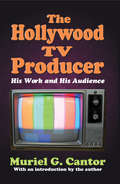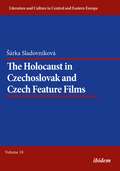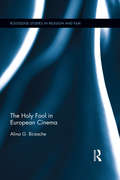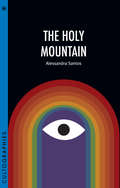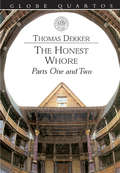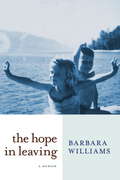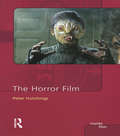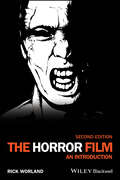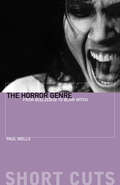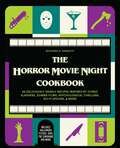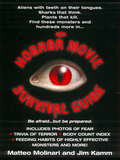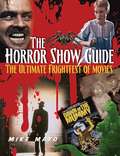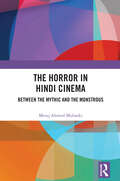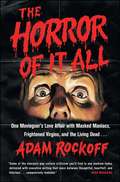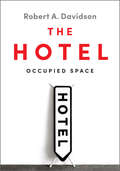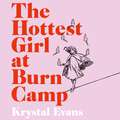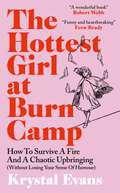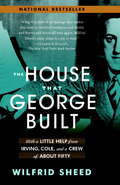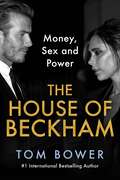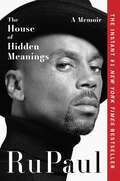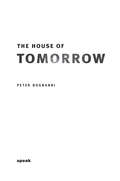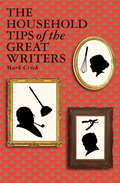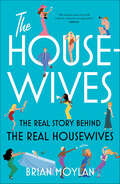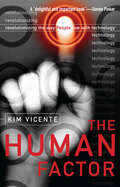- Table View
- List View
The Hollywood TV Producer: His Work and His Audience
by Muriel G. CantorExcept for accounts of journalists, dissident employees, and an occasional congressional committee focusing on crime and unethical practices, we have known very little about how television programs are produced. The Hollywood TV Producer, originally published in 1971, was the first serious examination of constraints, conflicts, and rewards in the daily lives of television producers. Its insights were important at the time and have not been challenged.Using as her framework the social system of mass communications, Muriel G. Cantor shows how producers select stories for television series and how movies end up in prime time. In order to get a comprehensive look at the inner workings of the TV industry and its producers, the author interviewed eighty producers in Hollywood over a two-season period. She probed to discover how the people producers work for and where they work influences their decision-making.As Cantor shows, critics of television who suggest that to remain in production, a producer must first please the business organization that finances his or her operations, are largely correct. Cantor shows that content is determined by a combination of artistic and professional factors, as well as social, economic, and political norms that have developed over time in the industry.
The Holocaust in Czechoslovak and Czech Feature Films (Literatur Und Kultur Im Mittleren Und Östlichen Europa Ser. #19)
by Šárka SladovníkováŠárka Sladovníková analyzes the depiction of the Holocaust in Czechoslovak and Czech feature films and the relevant literary pretexts. While she charts the social and cultural framework in which the films were made and how this framework changed, she also focuses on the cinematic language, the composition of and narration in each film (e.g., the depiction of the war and the Shoah as a narratively closed versus a narratively open event), genre aspects of the films (e.g., the use of comedy and humor), and convention and innovation in presenting motifs and characters (the division of gender roles, the character of the “good German”). Particular attention is paid to the portrayal of stereotypes and countertypes in the films, where already well-known images, situations, and backdrops are repeated and which meet viewers’ expectations or, in contrast, which form countertypes and countersituations that go against the grain. Many of the films analyzed are adaptations of literary works. Therefore, this book is also a contribution to the rapidly developing field of adaptation studies.
The Holy Fool in European Cinema (Routledge Studies in Religion and Film)
by Alina G. BirzacheThis monograph explores the way that the profile and the critical functions of the holy fool have developed in European cinema, allowing this traditional figure to capture the imagination of new generations in an age of religious pluralism and secularization. Alina Birzache traces the cultural origins of the figure of the holy fool across a variety of European traditions. In so doing, she examines the critical functions of the holy fool as well as how filmmakers have used the figure to respond to and critique aspects of the modern world. Using a comparative approach, this study for the first time offers a comprehensive explanation of the enduring appeal of this protean and fascinating cinematic character. Birzache examines the trope of holy foolishness in Soviet and post-Soviet cinema, French cinema, and Danish cinema, corresponding broadly to and permitting analysis of the three main orientations in European Christianity: Orthodox, Catholic, and Protestant. This study will be of keen interest to scholars of religion and film, European cinema, and comparative religion.
The Holy Mountain (Cultographies)
by Alessandra SantosAlejandro Jodorowsky's El Topo helped inaugurate the midnight movie phenomenon. Its success spawned The Holy Mountain, through interventions by John Lennon and Allen Klein. After a scandalous release and a 16-month midnight career, The Holy Mountain was relegated to the underground world of fan bootlegs for over thirty years until its limited restored release in 2007. This short study reveals how The Holy Mountain, a poetic, hilarious, and anarchist cult film by an international auteur, anchored in post-1968 critiques, is – at the same time – an archaeological capsule of the counterculture movement, a timely subversion of mystical tenets, and one of the most mysterious films in the history of world cinema.
The Honest Whore: With The Humours Of The Patient Man, And The Loving Wife (classic Reprint) (Globe Quartos)
by Thomas DekkerFirst Published in 1999. Routledge is an imprint of Taylor & Francis, an informa company.
The Hope in Leaving: A Memoir
by Barbara WilliamsHandsome Jack is a logger, nomad, and born dreamer. His young wife, Simone, has too many kids and never enough money to support or protect them. The family keeps on the move, shedding a grand total of twenty-seven homes. Their first child, Randy, is sensitive and brilliant and bold, protector of his younger siblings, the fearless star of their childhood adventures and misadventures--until something snaps inside him. The second child who comes a year after him, our narrator Barbara, is the lucky one, who can dream of getting out. Every time the family relocates, she feels "the hope in leaving and doing better next time."Poverty, mental illness, sexual abuse, and injustice pursue them wherever they go. They live small-town life hard and suffer, most of all Randy. The great surprise of The Hope in Leaving isn't that these characters descend increasingly into isolation and strife, but that despite this they remain a family, that there is always the spark of wit in their banter, and a kind of closeness no matter what happens, even a sense of normalcy. Gradually, the reader comes to understand why The Hope in Leaving is a book that had to be written. In it, Williams proves beyond doubt that there is one thing that can survive the worst of life and even death itself: love without judgment.From the Hardcover edition.
The Horror Film
by Peter HutchingsThe Horror Film is an in-depth exploration of one of the most consistently popular, but also most disreputable, of all the mainstream film genres. Since the early 1930s there has never been a time when horror films were not being produced in substantial numbers somewhere in the world and never a time when they were not being criticised, censored or banned. The Horror Film engages with the key issues raised by this most contentious of genres. It considers the reasons for horror's disreputability and seeks to explain why despite this horror has been so successful. Where precisely does the appeal of horror lie? An extended introductory chapter identifies what it is about horror that makes the genre so difficult to define. The chapter then maps out the historical development of the horror genre, paying particular attention to the international breadth and variety of horror production, with reference to films made in the United States, Britain, Italy, Spain and elsewhere. Subsequent chapters explore: The role of monsters, focusing on the vampire and the serial killer. The usefulness (and limitations) of psychological approaches to horror. The horror audience: what kind of people like horror (and what do other people think of them)? Gender, race and class in horror: how do horror films such as Bride of Frankenstein, The Texas Chainsaw Massacre and Blade relate to the social and political realities within which they are produced? Sound and horror: in what ways has sound contributed to the development of horror? Performance in horror: how have performers conveyed fear and terror throughout horror's history? 1970s horror: was this the golden age of horror production? Slashers and post-slashers: from Halloween to Scream and beyond. The Horror Film throws new light on some well-known horror films but also introduces the reader to examples of noteworthy but more obscure horror work. A final section provides a guide to further reading and an extensive bibliography. Accessibly written, The Horror Film is a lively and informative account of the genre that will appeal to students of cinema, film teachers and researchers, and horror lovers everywhere.
The Horror Film: An Introduction (New Approaches to Film Genre #3)
by Rick WorlandA lively and reliable narrative account of the horror genre, featuring new and revised material throughout The Horror Film: An Introduction surveys the history, development, and social impact of the genre. Covering American horror cinema from its earliest period to the present, this reader-friendly volume explores the many ways horror movies have been received by filmmakers, critics, and general audiences throughout the decades. Concise, easily accessible chapters describe historical instances of the genre's social reception based on primary research, analyze landmark films such as Frankenstein, Invasion of the Body Snatchers, and The Texas Chain Saw Massacre, and more. Incorporating recent scholarship on the genre, the second edition of The Horror Film contains new discussion and context for Hollywood horror films in the 1980s and 1990s, as well as notable developments in the genre such as “torture porn,” found-footage horror, remakes and reboots of past horror films, zombies, and the “elevated horror” debate. This edition explores the rise of new filmmakers such as Ari Aster, Robert Eggers, and Jordan Peele, surveys horror films made by women and African American filmmakers, and investigates contemporary issues in the production and consumption of horror films. Combining historical narrative with close readings of significant works, The Horror Film: Covers major works in the genre such as Cat People, Halloween, and Bram Stoker's Dracula Examines important antecedents including gothic literature and the Grand Guignol Theater Offers thorough analyses of the style, context, and themes of specific horror milestones Provides examples of close analysis that can be applied to a wide range of other horror films Discusses important representative titles across the genre's evolution, including more recent films such as 2017's Get Out The Horror Film: An Introduction, Second Edition, is an ideal textbook for undergraduate surveys of the horror genre and other courses in American film history, and an invaluable resource for scholars, lecturers, and general readers with an interest in the subject.
The Horror Genre: From Beelzebub to Blair Witch (Short Cuts)
by Paul WellsA comprehensive introduction to the history and key themes of the genre. The main issues and debates raised by horror, and the approaches and theories that have been applied to horror texts are all featured. In addressing the evolution of the horror film in social and historical context, Paul Wells explores how it has reflected and commented upon particular historical periods, and asks how it may respond to the new millennium by citing recent innovations in the genre's development, such as the "urban myth" narrative underpinning Candyman and The Blair Witch Project. Over 300 films are treated, all of which are featured in the filmography.
The Horror Movie Night Cookbook: 60 Deliciously Deadly Recipes Inspired by Iconic Slashers, Zombie Films, Psychological Thrillers, Sci-Fi Spooks, and More (Includes Halloween, Psycho, Jaws, The Conjuring, and More) (Gifts For Movie And Tv Lovers Ser.)
by Richard S. SargentSlay movie night with frighteningly delicious food and cocktail creations inspired by your favorite scary movies, perfect for fans of spooky season and movie buffs alike!If you're looking for kitschy Pinterest recipes like coffin-shaped cookies or zombie finger sandwiches, look elsewhere. With The Horror Movie Night Cookbook, you&’ll enjoy thoughtful and tasty food and cocktail pairings inspired by the actual content of chilling classics like Jaws, Psycho, Scream, The Conjuring, The Evil Dead, Halloween, and more of horror&’s most frightening favorites! Inside you&’ll find recipes like: Crawling Steak (Poltergeist) Campfire Sour (The Blair Witch Project) Zombie Baby Kale Salad (Dawn of the Dead) Bloody Floaties (Jaws) Alligator Bites (Crawl) The Mama&’s Boy Martini (Psycho) And more! This killer cookbook contains everything you'll need to be the star of your own horror-themed dinner party. So to quote a famous final girl, &“What are you waiting for?&”
The Horror Movie Survival Guide
by Jim Kamm Matteo MolinariFrom the scream of Psycho to the psycho of Scream, The Horror Movie Survival Guide is an essential source for information on the creatures and monsters that darken your daydreams and stalk your nightmares. Includes a directory of the scariest films, 30 photos of the creepiest monsters, and a body count index of the deadliest killers.
The Horror Show Guide
by Mike MayoFrom atomic bombs to zealous zombies, this cinefile's guidebook reviews 1,000 of the wickedest, weirdest, and wackiest scary movies from every age of horror. With reviews on many overlooked, underappreciated gems such as Alice Sweet Alice, Daughters of Darkness, and Zombie, as well as the numerous Stephen King adaptations and modern updates such as Night of the Living Dead 3D and The Wolfman, new devotees as well as the discriminating darkcinema enthusiast will love this big, beautiful, endall, beall guide to an always popular film genre. Established directors, including Wes Craven, John Carpenter, Tim Burton, David Cronenberg, and Guillermo del Toro are given their due, as are the new generation, represented by Larry Fessenden, James Wan, Alexandre Aja, and others. In addition to the hundreds of horror film reviews, this guide includes fascinating and fun top10 lists and sidebars that are designed to lead fans to similar titles they might not have known about.
The Horror in Hindi Cinema: Between the Mythic and the Monstrous
by Meraj Ahmed MubarkiThe book offers a lively and detailed analysis of the ideological subtext of Hindi Horror cinema. It unearths its codes and conventions, its relationship to spectatorship, the genre’s conjunctions and departures from Hollywood, and the unique features of Hindi horror. It posits the Hindi horror genre as a project of / for the ‘nation’ in the making.Analysing films from Mahal (1948) to Bhediya (2022), this book uncovers narrative strategies, frames unique approaches of investigation, and reviews the transformation taking place within the genre. It argues that Hindi horror cinema lies at the intersection of myths, competing ideologies, dominant socio-religious thoughts revealing three major strands of narrative constructs, each corresponding to the way the nation has been imagined at different times in post-colonial India. It establishes a theoretical framework of Hindi horror cinema, and demonstrates for the first time how this genre, with its subsets, provides a means to contemplate the nation.This volume will be useful to students, researchers and faculty members working in mass communication, journalism, political science, film studies, political sociology, gender / women studies, Culture studies and post-colonial Indian politics. It will also be an invaluable and interesting reading for those interested in South Asian popular culture studies.
The Horror of It All
by Adam RockoffPop culture history meets blood-soaked memoir as a horror film aficionado and screenwriter recalls a life spent watching blockbuster slasher films, cult classics, and everything in between. Horror films have simultaneously captivated and terrified audiences for generations, racking up billions of dollars at the box office and infusing our nightmares with unrelenting zombies, chainsaw-wielding madmen, and myriad incarnations of ghosts, ghouls, and the devil himself. Despite evolving modes of storytelling and the fluctuating popularity of other genres, horror endures. The Horror of It All is a memoir from the front lines of the industry that dissects (and occasionally defends) the hugely popular phenomenon of scary movies. Author Adam Rockoff traces the highs and lows of the horror genre through the lens of his own obsessive fandom, born in the aisles of his local video store and nurtured with a steady diet of cable trash. From Siskel and Ebert’s crusade against slasher films to horror’s Renaissance in the wake of Scream, Rockoff mines the rich history of the genre, braiding critical analysis with his own firsthand experiences. Be afraid. Be very afraid.
The Horror of Police
by Travis LinnemannUnmasks the horrors of a social order reproduced and maintained by the violence of police Year after year the crisis churns: graft and corruption, violence and murder, riot cops and armored vehicles claim city streets. Despite promises of reform, police operate with impunity, unaccountable to law. In The Horror of Police, Travis Linnemann asks why, with this open record of violence and corruption, policing remains for so many the best, perhaps only means of security in an insecure world. Drawing on the language and texts of horror fiction, Linnemann recasts the police not only as self-proclaimed &“monster fighters&” but as monsters themselves, a terrifying force set loose in the world. Purposefully misreading a collection of everyday police stories (TV cop dramas, detective fiction, news media accounts, the direct words of police) not as morality tales of innocence avenged and order restored but as horror, Linnemann reveals the monstrous violence at the heart of liberal social order. The Horror of Police shows that police violence is not a deviation but rather a deliberate and permanent fixture of U.S. &“law and order.&” Only when viewed through the refracted motif of horror stories, Linnemann argues, can we begin to reckon the limits of police and imagine a world without them.
The Hotel: Occupied Space
by Robert A. Davidson<p>The Hotel: Occupied Space explores the hotel as both symbol and space through the concept of “occupancy.” By examining the various ways in which the hotel is manifested in art, photography, and film, this book offers a timely critique of a crucial modern space. <p>As a site of occupancy, the hotel has provided continued creative inspiration for artists from Monet and Hopper, to genre filmmakers like Hitchcock and Sofia Coppola. While the rich symbolic importance of the hotel means that the visual arts and cinema are especially fruitful, the hotel’s varied structural purposes, as well as its historical and political uses, also provide ample ground for new and timely discussion. In addition to inspiring painters, photographers, and filmmakers, the hotel has played an important role during wartime, and more recently as a site of accommodation for displaced people, whether they be detainees or refugees seeking sanctuary. Shedding light on the diverse ways that the hotel functions as a structure, Robert A. Davidson argues that the hotel is both a fundamental modern space and a constantly adaptable structure, dependent on the circumstances in which it appears and plays a part.</p>
The Hottest Girl at Burn Camp: How to Survive a Fire and A Chaotic Upbringing (Without Losing Your Sense of Humour)
by Krystal Evans'Krystal Evans is a born writer - from the first page you know you are in the hands of someone who knows what the hell she's doing. This a wonderful book: funny, heart breaking, beautifully paced - I don't expect to read a better memoir for a very long time.' ROBERT WEBB, author of How Not To Be A Boy'Funny and heart breaking in equal measure, Krystal's cool, clear voice cuts through the noise of growing up in chaos' FERN BRADY, author of Strong Female Character'The guiltiest of literary pleasures: a memoir that you open with trepidation and stay up til 6am to finish' KATE SPICER, author of Lost Dog.'Krystal's writing is compelling, edgy and always hilarious. Hottest Girl At Burn Camp is so much more than your average comedian's memoir. Absolutely essential reading.' JOSIE LONGWhen Krystal Evans was 14, the house that she shared with her mother and little sister burned down. Narrowly escaping by breaking a window and jumping out head-first Krystal suffered burns, smoke inhalation, and the unimaginable tragedy of losing her sister. That Evans has written such a warm and disarmingly funny memoir about what led the family to that fatal night, and how they coped with its aftermath, is nothing less than astonishing.This is a spellbinding story of growing up poor in America, living with a mentally ill mother, and having a wolf for a pet (really). From the indignities of being rejected from a summer camp for burn victims, to putting up with a succession of her mom's increasingly shady friends and partners, Krystal and Katie's childhoods were marked by adult chaos, inappropriate behaviour, and never knowing what the next day would bring.But, writing with joy, skill and candour, we witness Krystal growing as a person from the ashes of disaster into the confident, funny, and (reasonably) well-hinged adult, mother and comedian that she is today.At the same time, funny, tragic and inspiring, it is the story of a family dangerously close to the edge, and of a girl struggling to make her way into adulthood, once the smoke clears.
The Hottest Girl at Burn Camp: How to Survive a Fire and A Chaotic Upbringing (Without Losing Your Sense of Humour)
by Krystal Evans'Krystal Evans is a born writer - from the first page you know you are in the hands of someone who knows what the hell she's doing. This a wonderful book: funny, heart breaking, beautifully paced - I don't expect to read a better memoir for a very long time.' ROBERT WEBB, author of How Not To Be A Boy'Funny and heart breaking in equal measure, Krystal's cool, clear voice cuts through the noise of growing up in chaos' FERN BRADY, author of Strong Female Character'The guiltiest of literary pleasures: a memoir that you open with trepidation and stay up til 6am to finish' KATE SPICER, author of Lost Dog.'Krystal's writing is compelling, edgy and always hilarious. Hottest Girl At Burn Camp is so much more than your average comedian's memoir. Absolutely essential reading.' JOSIE LONGWhen Krystal Evans was 14, the house that she shared with her mother and little sister burned down. Narrowly escaping by breaking a window and jumping out head-first Krystal suffered burns, smoke inhalation, and the unimaginable tragedy of losing her sister. That Evans has written such a warm and disarmingly funny memoir about what led the family to that fatal night, and how they coped with its aftermath, is nothing less than astonishing.This is a spellbinding story of growing up poor in America, living with a mentally ill mother, and having a wolf for a pet (really). From the indignities of being rejected from a summer camp for burn victims, to putting up with a succession of her mom's increasingly shady friends and partners, Krystal and Katie's childhoods were marked by adult chaos, inappropriate behaviour, and never knowing what the next day would bring.But, writing with joy, skill and candour, we witness Krystal growing as a person from the ashes of disaster into the confident, funny, and (reasonably) well-hinged adult, mother and comedian that she is today.At the same time, funny, tragic and inspiring, it is the story of a family dangerously close to the edge, and of a girl struggling to make her way into adulthood, once the smoke clears.
The House That George Built: With a Little Help from Irving, Cole, and a Crew of About Fifty
by Wilfrid SheedFrom Irving Berlin to Cy Coleman, from "Alexander's Ragtime Band" to "Big Spender," from Tin Pan Alley to the MGM soundstages, the Golden Age of the American song embodied all that was cool, sexy, and sophisticated in popular culture. For four glittering decades, geniuses like Jerome Kern, George Gershwin, Cole Porter, and Harold Arlen ran their fingers over piano keys, enticing unforgettable melodies out of thin air. Critically acclaimed writer Wilfrid Sheed uncovered the legends, mingled with the greats, and gossiped with the insiders. Now he's crafted a dazzling, authoritative history of the era that "tripled the world's total supply of singable tunes." It began when immigrants in New York's Lower East Side heard black jazz and blues--and it surged into an artistic torrent nothing short of miraculous. Broke but eager, Izzy Baline transformed himself into Irving Berlin, married an heiress, and embarked on a string of hits from "Always" to "Cheek to Cheek." Berlin's spiritual godson George Gershwin, in his brief but incandescent career, straddled Tin Pan Alley and Carnegie Hall, charming everyone in his orbit. Possessed of a world-class ego, Gershwin was also generous, exciting, and utterly original. Half a century later, Gershwin love songs like "Someone to Watch Over Me," "The Man I Love," and "Love Is Here to Stay" are as tender and moving as ever. Sheed also illuminates the unique gifts of the great jazz songsters Hoagy Carmichael and Duke Ellington, conjuring up the circumstances of their creativity and bringing back the thrill of what it was like to hear "Georgia on My Mind" or "Mood Indigo" for the first time. The Golden Age of song sparked creative breakthroughs in both Broadway musicals and splashy Hollywood extravaganzas. Sheed vividly recounts how Cole Porter, Richard Rodgers, Jerome Kern, and Johnny Mercer spread the melodic wealth to stage and screen. Popular music was, writes Sheed, "far and away our greatest contribution to the world's art supply in the so-called American Century." Sheed hung out with some of the great artists while they were still writing-and better than anyone, he knows great music, its shimmer, bite, and exuberance. Sparkling with wit, insight, and the grace notes of wonderful songs, The House That George Built is a heartfelt, intensely personal portrait of an unforgettable era. A delightfully charming, funny, and most illuminating portrait of songwriters and the Golden Age of American Popular Song. Mr. Sheed's carefully chosen depictions and anecdotes recapture that amazingly creative period, a moment in time in which I was so fortunate to be surrounded by all that magic." -Margaret Whiting
The House of Beckham: Money, Sex and Power
by Tom BowerFor fans and watchers of the Beckham Netflix documentary who want the rest of the story—an explosive tell-all account of the real lives of David and Victoria Beckham.As one of the most famous and influential couples in the world, David and Victoria Beckham have attained iconic status. The ultimate power couple have together built a multi-billion-dollar global brand. For decades, adoring fans have been captivated by the glamorous world they have created, while their unrivalled fusion of showbiz, fashion, football and celebrity has been cultivated alongside the image of a strong marriage. When the much-trailed Netflix documentary Beckham aired in 2023, viewers were offered an even more intimate insight into their private lives. Produced by the Beckhams themselves, the series raised many questions, not only about their success and personal relationship, but also about the ruthlessly successful management of their image in the media. Are their lives really as perfect as the Beckhams would like the world to believe?Through extensive research, expert sourcing and interviews with insiders, Britain’s most celebrated investigative biographer, Tom Bower, has unearthed a succession of revelations that give surprising insight into the reality of ‘Brand Beckham’. Exploring the couple’s relationship, and the truth about their football and fashion careers, their finances and their new life in Miami, The House of Beckham unravels the extraordinary reality of the business-savvy cultural icons to tell an engrossing, often astonishing story of money, sex and power.
The House of Hidden Meanings: A Memoir
by RuPaul***An Instant #1 New York Times Bestseller!***From international drag superstar and pop culture icon RuPaul, comes his most revealing and personal work to date--a deeply intimate memoir of discovery, found family, and self-acceptance. The House of Hidden Meanings is a self-portrait of the legendary icon on the road to global fame and changing the way the world thinks about drag.Central to RuPaul’s success has been his chameleonic adaptability. From drag icon to powerhouse producer of one of the world’s largest television franchises, RuPaul’s ever-shifting nature has always been part of his brand as both supermodel and supermogul. Yet that adaptability has made him enigmatic to the public. In this memoir, his most intimate and detailed book yet, RuPaul makes himself truly known.In The House of Hidden Meanings, RuPaul strips away all artifice and recounts the story of his life with breathtaking clarity and tenderness, bringing his signature wisdom and wit to his own biography. From his early years growing up as a queer Black kid in San Diego navigating complex relationships with his absent father and temperamental mother, to forging an identity in the punk and drag scenes of Atlanta and New York, to finding enduring love with his husband Georges LeBar and self-acceptance in sobriety, RuPaul excavates his own biography life-story, uncovering new truths and insights in his personal history.Here in RuPaul’s singular and extraordinary story is a manual for living—a personal philosophy that testifies to the value of chosen family, the importance of harnessing what makes you different, and the transformational power of facing yourself fearlessly.A profound introspection of his life, relationships, and identity, The House of Hidden Meanings is a self-portrait of the legendary icon on the road to global fame and changing the way the world thinks about drag. “I've always loved to view the world with analytical eyes, examining what lies beneath the surface. Here, the focus is on my own life—as RuPaul Andre Charles,” says RuPaul.If we’re all born naked and the rest is drag, then this is RuPaul totally out of drag. This is RuPaul stripped bare.
The House of Tomorrow
by Peter Bognanni* "Funny and unique . . . An honest, noisy, and raucous look at friendship and how loud music can make almost everything better." --Publishers Weekly, starred reviewSebastian Prendergast lives with his eccentric grandmother in a geodesic dome. His homeschooling has taught him much-but he's learned little about girls, junk food, or loud, angry music. Then fate casts Sebastian out of the dome, and he finds a different kind of tutor in Jared Whitcomb: a chain-smoking sixteen-year-old heart transplant recipient who teaches him the ways of rebellion. Together they form a punk band and plan to take the local church talent show by storm. But when his grandmother calls him back to the futurist life she has planned for him, he must decide whether to answer the call-or start a future of his own.
The Household Tips of the Great Writers
by Mark CrickWhat would literary lions tell us about cooking, cleaning, and gardening? A three-book collection of parody and practical advice by a &“brilliant&” humorist (The Financial Times). The Household Tips of Great Writers covers all your household needs, indoors and outdoors, from pruning a rose bush with Pablo Neruda to mending a dripping tap with Jean-Paul Sartre. Throwing a tea party? Irvine Welsh has the recipe for the perfect chocolate cake, though that's not all he's cooking. Brilliant, hilarious, and always pitch-perfect, this omnibus edition of Mark Crick's wonderful books of literary pastiche will inform and entertain the most erudite of householders. Includes: Sartre&’s Sink &“This brilliantly inventive DIY manual both parodies and celebrates great authors ... Crick is a brilliant literary ventriloquist.&”—The Financial Times Kafka&’s Soup &“These literary and visual pastiches of writers and their relationships with food provide a laugh a line as they skewer their literary originals with effortless accuracy...a masterpiece.&”—The Guardian Machiavelli&’s Lawn &“Erudite and enjoyable prose, no less rewarding for its horticultural accuracy.&”—Times Literary Supplement
The Housewives: The Real Story Behind the Real Housewives
by Brian MoylanINSTANT NEW YORK TIMES BESTSELLER From Brian Moylan, the writer of Vulture’s legendary Real Housewives recaps, a table-flipping, finger-pointing, halter-topping VIP journey through reality TV’s greatest saga…In the spring of 2006, a new kind of show premiered on Bravo: The Real Housewives of Orange County. Its stars were tanned, taut, and bedazzled; their homes were echoey California villas; and their drama was gossip-fueled, wine-drenched, and absolutely exquisite. Fifteen seasons on, RHOC is an institution, along with The Real Housewives of New York, Atlanta, New Jersey, Miami, Potomac, and more. Over the years these ladies have done a lot more than lunch, launching thirty-one books, a cocktail line, two jail sentences, a couple supermodel daughters, Andy Cohen’s talk show career, thirty-six divorces, fourteen albums, a White House party crash, and approximately one million memes.Brian Moylan has been there through it all, in front of the screen and behind the scenes. The writer of Vulture’s beloved series recaps, he’s here to tell us the full story, from the inside scoop on every classic throwdown to the questions we’ve always wanted to know, like—what are the housewives really like off-camera? (The same.) How much money do they make? (Lots.) He has a lot to say about the legacy and fandom of a franchise that’s near and dear to his heart, and inextricable from pop culture today.A must-have for any fan of real drama and fake [redacted], The Housewives is the definitive companion to an American TV treasure.
The Human Factor: Revolutionizing the Way People Live with Technology
by Kim J. VicenteIn this incessantly readable, groundbreaking work, Vincente makes vividly clear how we can bridge the widening gap between people and technology. He investigates every level of human activity - from simple matters such as our hand-eye coordination to complex human systems such as government regulatory agencies, and why businesses would benefit from making consumer goods easier to use. He shows us why we all have a vital stake in reforming the aviation industry, the health industry, and the way we live day-to-day with technology.
